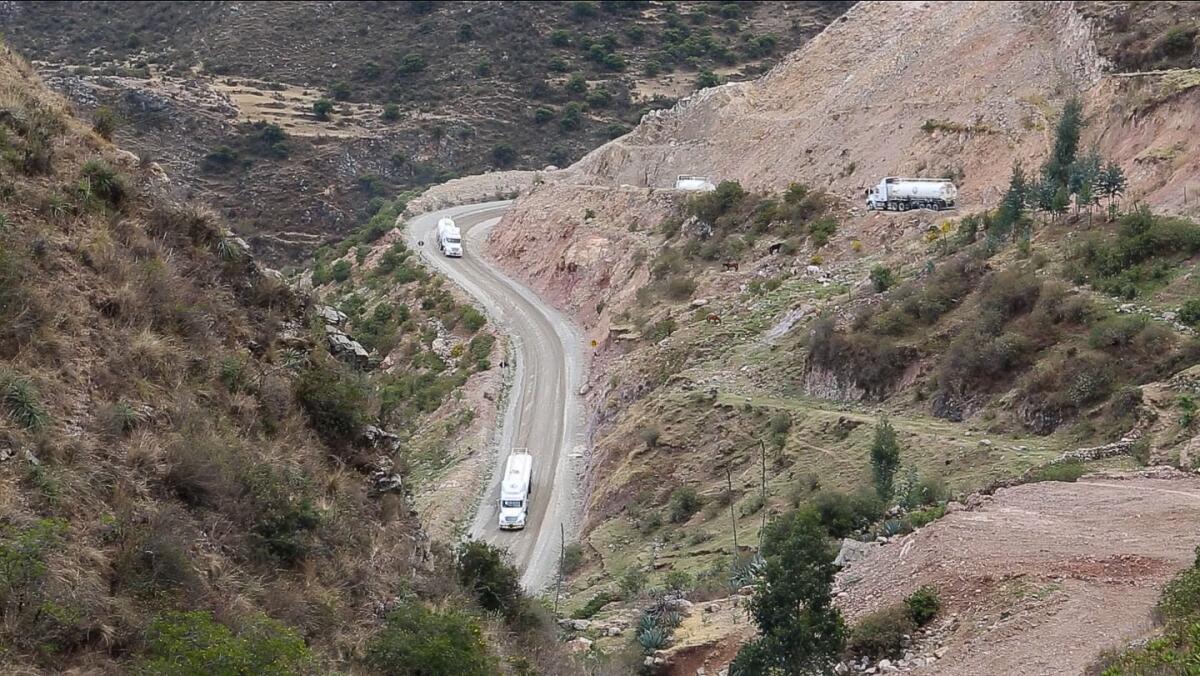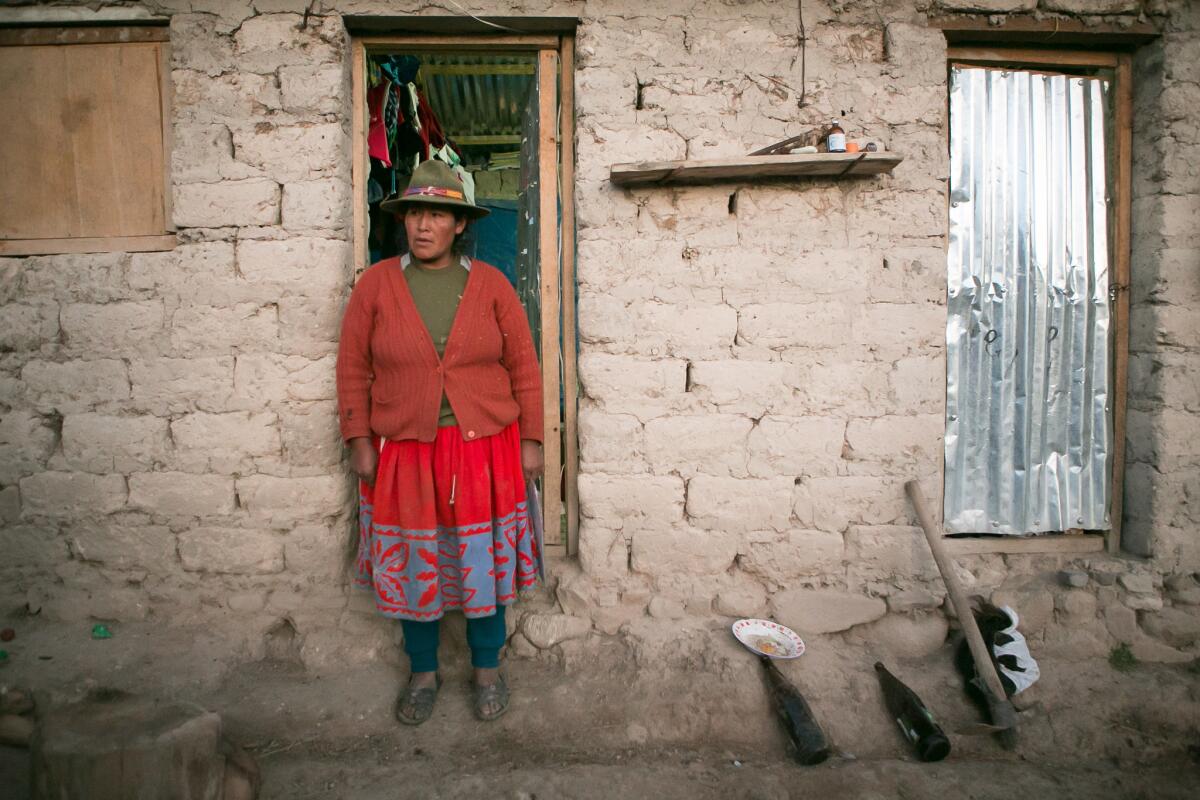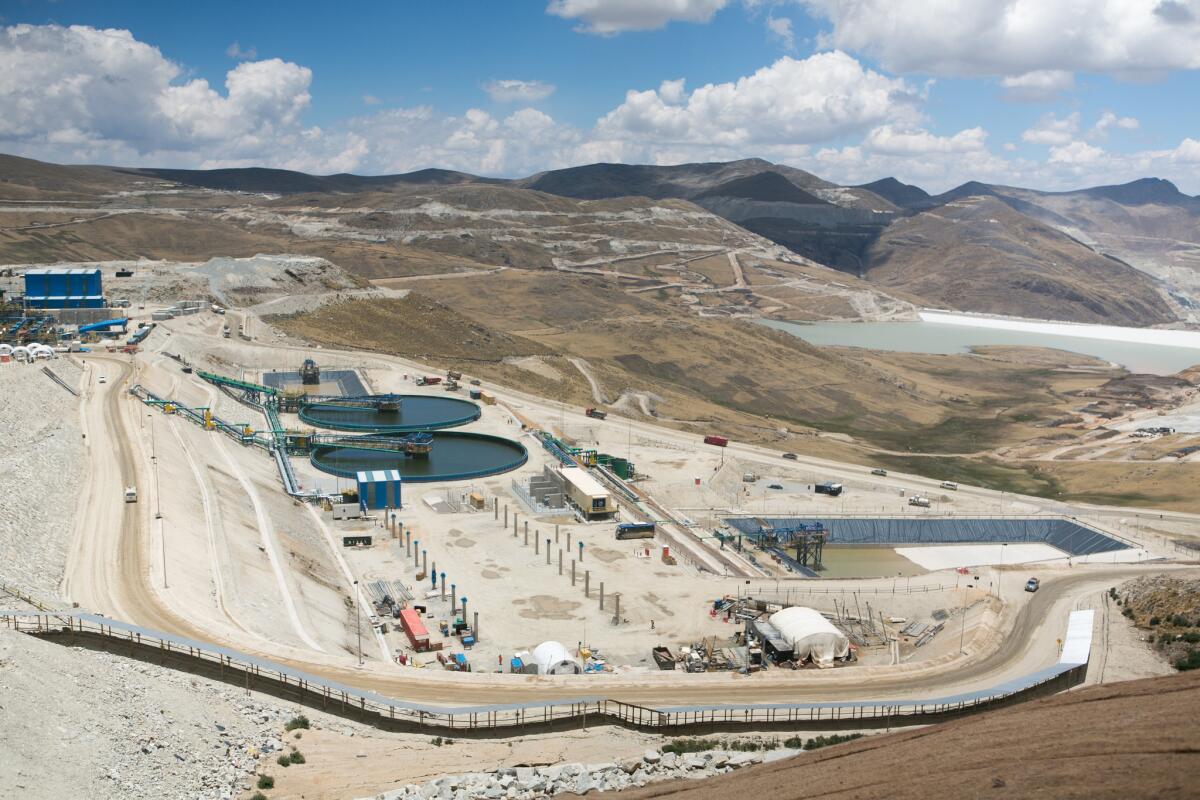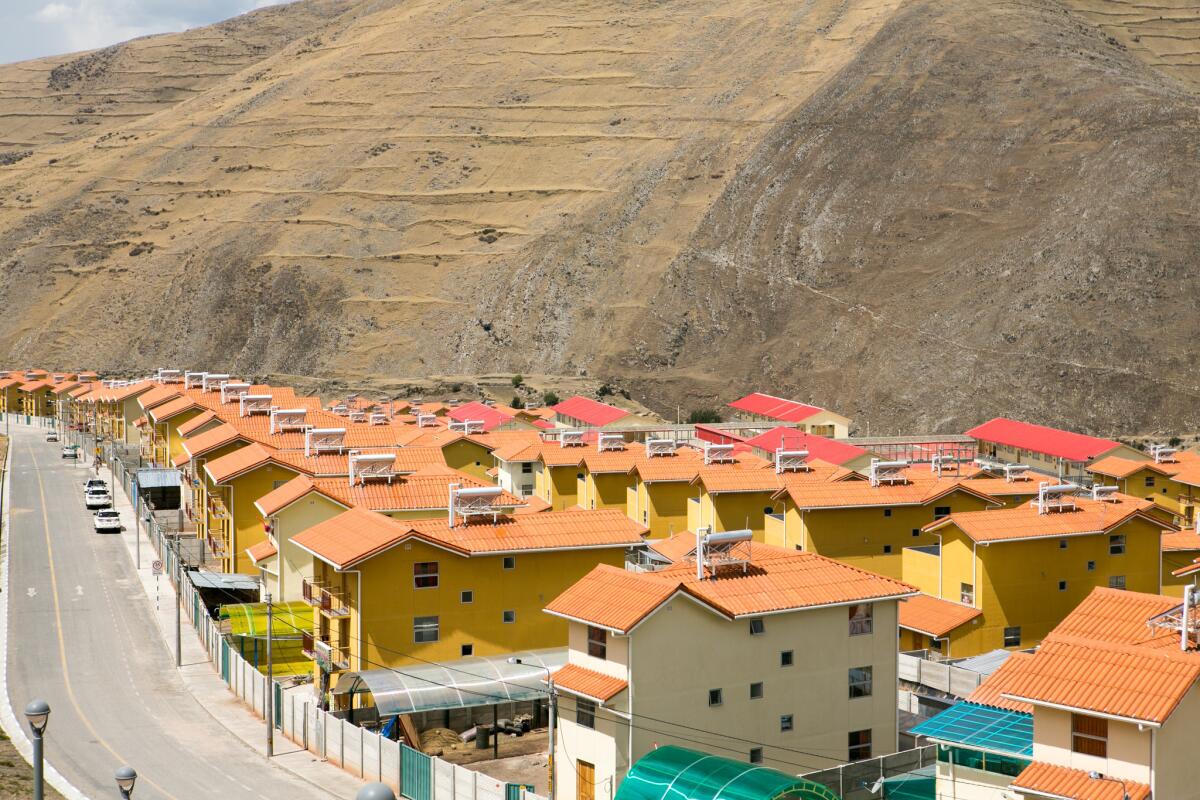Peru has copper. China wants it. And now Beto Chahuayllo is dead.

Las Bambas mine is expected to produce 450,000 tons of copper annually for the next 20 years, making it one of the largest copper mines in the world.
Reporting from Cotabambas, Peru — When the Chinese took over the Las Bambas copper mine here in the Andes Mountains in 2014, Beto Chahuayllo at first barely noticed the change.
He kept on painting buildings at the mine, a job he’d been doing for four years in hopes of saving enough to leave his village and his dirt-floor hut and move his family to nearby Cuzco, where the houses have electricity and his children could attend a better school.
The new owners, a conglomerate of Chinese state-owned companies, bought the mine while it was still under construction, paying $5.85 billion to the Swiss firm that had started developing it.
The Peruvian government welcomed the new investors, predicting that Las Bambas — a gray gash across the mountains set to be second biggest copper mining operation in the world — would boost Peru’s gross domestic product by 1.4% once production began.
NEWSLETTER: Get the day’s top headlines from Times Editor Davan Maharaj >>
The deal was part of China’s dramatic expansion into Latin America over the last decade, a relationship that has brought enormous benefits to both sides. But China’s investments in the region have increasingly met resistance from the people whose voices register least in the global economy.
One day, in the nearby provincial capital of Tambobamba, graffiti appeared on a white construction barrier. In bold red letters, somebody wrote: “Say no to the Chinese.”
It was an early sign of the trouble that would soon engulf the communities around the mine. The protests against it would eventually cost Chahuayllo his life.
::

Chinese ownership of a Peruvian copper mine.
It seemed a perfect match.
In Latin America, China found a new supply of commodities to help fuel its monumental economic growth. And in China, Latin America found a way to ride the coattails of that growth.
Between 2001 and 2013, China’s total investment in Latin America and the Caribbean grew from $1 billion to $86 billion, as state-owned companies slurped up oil from Ecuador and Venezuela, soybeans from Argentina and Brazil and copper from Chile and Peru.
The investment helped drive the strongest economic performance that Latin America had seen since the 1970s, with GDP growth averaging roughly 3% a year.
“Finance ministries loved it, and so did the heads of state,” said Kevin Gallagher, a professor at Boston University who studies Chinese investment in the region.
That was especially true in the wake of the world financial crisis of 2008, when exports to the United States and Europe fell. “China became this new growth pole,” Gallagher said.
But as China and Latin America have deepened their relationship, not everybody has been so welcoming.
In Honduras in 2013, the indigenous Lenca people blocked access to the Chinese-backed Agua Zarca dam, which they said was in their territory, sparking clashes with local security forces. Honduran police shot and killed a protest leader, and Sinohydro — the world’s biggest hydropower contractor — eventually terminated the project.
In Ecuador in 2014, an indigenous leader battling a $1.4-billion Chinese-backed mine disappeared the day before a scheduled protest over deforestation and displacement of indigenous people. Four days later, his bound and battered body was discovered in an unmarked grave.
And since the Chinese state-run firm Shougang acquired an iron mine in 1992 in Marcona, on Peru’s southern coast, the project has been beset by near-constant unrest over environmental concerns and labor conditions. Last May, police killed a labor organizer during a protest.
The conflicts in some respects reflect growing pains. Many Chinese companies are still learning how to navigate diverse, politically complex countries far from home, said Cynthia Sanborn, vice president for research at the University of the Pacific in Lima, Peru’s capital.
“When you’re in countries that are both democratic and tumultuous — those that have diverse civil societies with diverse needs — you have to deal with them,” she said. “The learning curve is steeper, and they have to learn things that other companies learned generations ago.”
China believed its newest copper mine was a test it could pass.
“Las Bambas was supposed to be the poster child for responsibility in new mining,” Sanborn said.
::

Agustine Llusca Aguilar, 35, the widow of Beto Chahuayllo, outside her house in Arcospampa, Peru.
China’s interest in the mine is clear.
The country is addicted to copper, last year gobbling up as much as the rest of the world combined to cast into pipes for new cities and wire into consumer electronics to ship around the globe.
Peru, the world’s third largest producer of the metal, is one of the biggest beneficiaries of that addiction. While China still invests far less than the U.S. in Latin America and the Caribbean on the whole, its stake in Peru is three times larger.
Las Bambas was to benefit not only Peru but also the communities around the mine.
In some ways, it has. Starting under Swiss ownership, the mine has boosted the local economy and helped modernize the region.
“When we got in there in 2004, there wasn’t even currency — people would exchange goods in the market,” said Luis Rivera, a Peruvian and Las Bambas’ vice president of operations. “No banks, no phones, no IDs. We had to establish a bank, mobile phones, the Internet.”
The mine became the largest employer in the Apurimac region, which has one of Peru’s highest poverty rates. It put 18,000 people to work — directly and indirectly — during its construction.
The new owners — led by 62.5% stakeholder MMG, a Melbourne, Australia-based subsidiary of China Minmetals Corp. — built a town known as Nueva Fuerabamba for villagers displaced by the mine. Compared with the surrounding villages, it is a model of progress, with freshly paved roads, 441 sturdy yellow houses, a health clinic, running water and three churches, each for a different Christian denomination.
“We also give them a relocation bonus — compensation for the lifestyle they have to leave,” said Socrates Cornejo, a Las Bambas community relations officer.
But the mine has brought little benefit to many others who live near it, and their discontent was mounting.
Chahuayllo, a leader of the committee that represented his tiny village in meetings with mine officials and the government, started hearing concerns that pollution from the mine could threaten the local fishing and farming industries.
Residents were worried about the possibility that chemicals might seep into surrounding rivers and the mountainsides.
They seized on two major changes the new owners — with the blessing of the Peruvian government — made to the original plans.
First, the Chinese added a second factory to process deposits of the mineral molybdenum, and it seemed precariously close to the Challhuahuacho River. Second, rather than build a pipeline to send the copper concentrate to the Pacific port of Matarani, the company decided to haul it by truck, raising fears of endless dust and toxic spills along the 450-mile route.
More immediate than those complaints was another: Once the mine started producing copper, more than three-quarters of the jobs created during the construction phase would disappear.
“The company came with many promises of money, opportunities and work,” said Roselle Chihualro, Chahuayllo’s brother. “But we have been cheated.”
A local politician, Rodolfo Abarca, accused the mine of failing to provide infrastructure and agricultural investments it had promised. “Why do we have this big project here — this very important project — and we are still poor?” he said recently.
Chahuayllo started attending meetings of workers. They wondered how they could have their voices heard, either by their own government or the Chinese executives who spent most of their time outside of Peru.
::

The Las Bambas mine in Peru.
Brewing anger turned to a labor strike and open protest last year.
For three days in September, 36-year-old Chahuayllo, his brother and thousands of other poor Peruvians gathered on the outskirts of Challhuahuacho, a ramshackle town at the foot of the mine.
His wife, Agustine Llusca Aguilar, stayed home with the five children to tend their horses, lambs and guinea pigs.
The shouts of the protesters echoed in the surrounding hills, swelling into a dull roar. Some waved sticks and slingshots. A few flicked cigarettes into the dry grass, sparking small fires that sent wisps of smoke into the bright blue sky.
See more of our top stories on Facebook >>
Perched above the throng at the entrance to the mine, about 1,500 Peruvian police officers stood guard. On the third day of the protests, as tensions rose, they fired tear gas into the air.
“Some people were trying to run away, some people were crying, and some were insisting on attacking the policemen with the slingshots,” Chihualro recalled.
He said his brother trudged uphill toward the police, raising his hands and chanting with the crowd, “Let’s negotiate.”
Then shots rang out, and he fell.
When his brother reached him, blood was gushing from a bullet wound on his right side. “Brother, wake up, please,” Chihualro said he pleaded.
Chahuayllo died that evening at a nearby clinic, one of at least three protesters villagers say were shot and killed by police.
::

Nueva Fuerabamba, a newly constructed town built by MMG for Peruvians displaced by Las Bambas mine.
The next day, Peruvian President Ollanta Humala dispatched military patrols throughout the region, placing four Andean provinces under a state of emergency that would last for a month.
Soldiers patrolled the streets in major towns and cities. Political gatherings were banned.
“A few thousand people led by a few cannot stop a project of this size,” the interior minister, Jose Luis Perez, told reporters.
A week later, community leaders reached an agreement with the Peruvian government, officially ending the strike. The government promised to end the state of emergency and compensate families of those injured or killed during the protest.
Later that month, the chief executive of Minmetals, He Wenbo, met with the Peru’s deputy minister of mining in Beijing. According to the company, he promised that MMG would “fuel the development of the local communities in Peru.”
Rivera, the Las Bambas executive, said that the protesters had “some legitimate grievances” about labor and environmental issues, but he declined to go into detail. The Peruvian government has agreed to hold workshops in the area to discuss local communities’ environmental concerns.
Several dozen locals have refused to leave their old stone-and-mulch homes and move into Nueva Fuerabamba, the newly built neighborhood.
One of the holdouts, Porfirio Gutierrez Paniura, said the compensation package was too small. “We have more land, more animals, and more things to lose, way more than the people who left,” he said.
“We were OK with the mine,” Paniura said. “But we want them to understand that we have our richness, and that it has its price.”

Conveyor belts transport raw material from the Las Bambas open pit to processing facilities.
China’s demand for copper continues to rise, even as its economy has been slowing, driving down world commodity prices and rippling through Latin America economies, which are expected to contract slightly this year.
Last month MMG announced that Las Bambas made its first shipment, sending 10,000 tons of copper concentrate to China. The mine is expected to produce 450,000 tons of copper annually for the next two decades.
MORE WORLD NEWS
Murder, torture, drugs: Cartel kingpin’s wife says that’s not the ‘El Chapo’ she knows
President of Egypt says he would sell himself if it would help the economy
South Korean lawmakers try first filibuster since 1969 to block anti-terrorism bill
More to Read
Sign up for Essential California
The most important California stories and recommendations in your inbox every morning.
You may occasionally receive promotional content from the Los Angeles Times.










